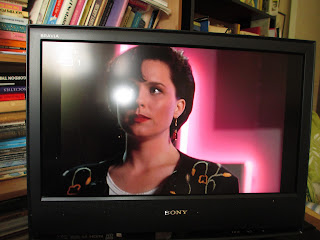 |
| What makes you think that, Mrs Fletcher? |
Was 80s design all Memphis and Sotsass – bizarre shapes, graffiti scrawls and primary colours? 80s design was many things. Kate of the wonderful
mirror80.com blog sums up:
Rattan flourishes, especially on furniture
A tropical palette, reflected in soft-toned floral fabric and teal cushions
Lush vegetation motifs, from house and patio plants to fabrics and wall decor
Ceramic vases in signature ’80s colors
Asian touches, such as porcelain vases and wall art
(Mirror80.com on
Golden Girls style)
Brass accents, tessellated stone that covers each piece in seamlessly applied squares, and Deco-style geometric shapes. (mirror80.com)
Anything with a grid on it. (mirror80.com)
Stair-step and diamond motifs. Teal, mauve, peach, purple and turquoise. (mirror80.com)
Rattan furniture, tropical vegetation and animal motifs were distinct trends of the time. Even the prominent clouds peeking in from the window [white painted, lattice French doors half open] … were a signature ’80s theme, often showcased in surreal artwork of the era. [French doors have white venetian blinds, there’s a rattan circular glass-topped table and a screen painted with a palm tree and lianas.] (mirror80.com)
Perhaps she’ll do
Murder She Wrote now – Jessica is always staying in a hotel room with pastel flowery paper, pale Chinese vases and fabulous wall art. And the villains’ offices are full of potted palms.
There were many themes to choose from:
ORIENTAL
Black lacquer bedroom suites vaguely copied 30s and Japanese style. You sat at the dressing table in front of the pink shell-shaped mirror wearing an acetate kimono or Chinese style viscose dress with a large lily motif. Tables were low, black and Chinese style with curved legs. Art and square lanterns had Chinese characters allegedly for Life, Health and Happiness.
Translucent walls with a grid pattern recalled Japanese paper room dividers. The room was lit with square pleated paper lampshades. On the walls hung hexagonal Feng Shui mirrors and outsized red paper fans. Fan patterns were common, especially on the back of your pale pink kimono, combined with Japanese mon designs of cranes, wheat, bamboo, geometric symbols. Bamboo was big, bamboo chairs were black, and you ate off black hexagonal plates.
TWEE
There was a hedgehog+brambles+conkers aesthetic. Probably with berries. And autumn leaves and blackberries – Brambly Hedge. Corn dollies, straw hats with straw flowers, and miniature versions of the same, went with this look. The Flower Fairies were fashionable – were the books reprinted? I’m seeing apple blossom. There were endless Country Diary of an Edwardian Lady products, and Country Living magazines.
PASTEL
Apricot, chalky blue, primrose yellow. You could do a whole room in pastels with diagonal slashes, tulips, coolie-hat lampshades, Chinese vases, ikat fabrics.
HIGH TECH
Graphic designers in red-framed uber-spectacles worked at home and decorated their entire home in graph paper: mugs, fablon, curtains, probably coasters and cushions. Green on white or red on white. Room dividers and wall units were made of bolted-together scaffolding with chickenwire panels, or sheets of aluminium with holes like offcuts from some industrial process. Or was the inspiration punched paper tape from old computers? The inmates slept on futons and threw rubbish into wire bins. They used offcuts of hardboard with holes in to hang things off (with coloured pegs and wire hooks). Their children slept in wooden bunk beds with built-in desks, and their wives hung their kitchen equipment from butcher’s hooks.
ART DECO
The look revolved around huge fake Art Deco glass scent bottles (perhaps the real thing were for bath salts, not scent), “keystone” mirrors, round mirrors, apricot and mint colour schemes, curved vases, Hollywood beds on platforms. Pictures showed women with marcel waves getting into vintage taxis, or a single cocktail glass.
NOSTALGIA
Heavily influenced by the Victorians, this look combined flowery wallpaper, a flowery dado strip, a stripy dado, round tables with a long tablecloth, cushions, crocheted curtains, chintz, stencils, pastel pleated coolie-hat lampshades, crocheted lampshades (both terrible dust traps), roses, frills, pink, lace, stripes, pelmets, collectables, German rustic wooden kitchens, dried flowers, dressers stacked with flowery china, pine, pine, pine… with apricot. And then IKEA told us to "chuck out the chintz" and "don't let that doily spoil everything".
AWFUL
Very posh interiors had yellow walls and an antique globe. Sloane Rangers tried to recreate a stately home in a small flat in Fulham with a lot of forest green and burgundy, chintz and elaborate pelmets. Their china was dark green with a gold rim, or white with fluting. They liked original Victorian dark marble fire surrounds and prints of prisons by Piranesi. Their Redouté rose prints are now all faded and found at boot sales.
The middle classes went for chrome yellow, green and tomato, on twee fabric printed with all-over giraffes, stars or bears. Red and green tulip prints on chrome yellow. Rainbows in children’s bedrooms. French navy/old rose/jade/gold tiles in the kitchen. They painted floorboards white and scattered handwoven rugs that wrinkled, gathered dust and tripped you up. They filled low shelves with nicknacks from their holidays in Nicaragua and Nepal, sent each other greetings cards with sentimental cartoons, and read their children right-on fairy stories (“And so she left the prince in his palace and walked off alone into the sunset dressed in a brown paper bag”).
Essex Man loved square mirrors set diamond-wise, mirrors printed with pubiana or palm trees, amusing teapots, lamps with a globe in two hands, miniature or life-size film spotlights, glass-topped tables, lots of chrome and brass. And a jukebox.
Yes, I know I’ve skipped the 70s.

















